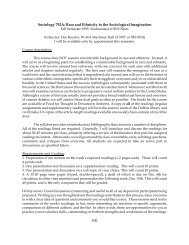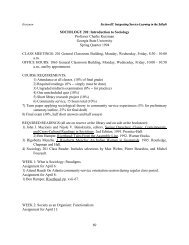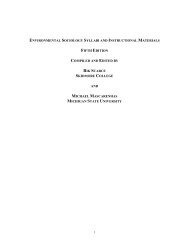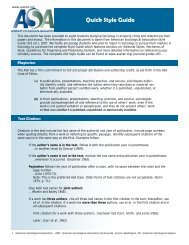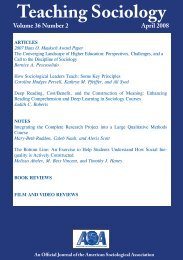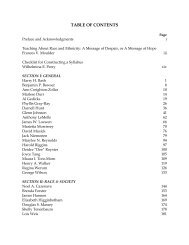Social Problems - American Sociological Association
Social Problems - American Sociological Association
Social Problems - American Sociological Association
Create successful ePaper yourself
Turn your PDF publications into a flip-book with our unique Google optimized e-Paper software.
Syllabus—Hamil-Luker University of North Carolina, Chapel Hill<br />
_____________________________________________________________________________________________<br />
“Should We Ration Health Care for Older People?” by Harry R. Moody<br />
Question: Should we ration healthcare on the basis of age?<br />
Final Exam:<br />
Your final exam will be worth 100 points. The test will consist of multiple choice, short answer, and essay<br />
questions. If you have kept up with the readings throughout the semester and participated in class discussions, you<br />
will do well on the exam.<br />
HONOR CODE<br />
The Honor Code is in effect at all times during this course. Specifically, this means that you sign a pledge on all<br />
written work, stating “On my honor, I have neither given nor received unauthorized aid on this assignment.” This<br />
applies to all quizzes, papers and exams. The first time you hand in an assignment, I expect you to write the entire<br />
pledge. On future assignments, simply write “Pledge” and sign your name.<br />
TEXTS AND READINGS<br />
1. Racism: An <strong>American</strong> Cauldron by Christopher Bates Doob<br />
2. “Getting Paid:” Youth Crime and Work in the Inner City by Mercer L. Sullivan<br />
3. Articles are on reserve in the library.<br />
COURSE OUTLINE AND READINGS<br />
I. Introduction to Reading and Thinking Critically About <strong>Social</strong> <strong>Problems</strong><br />
May 21 What is a social problem?<br />
Introduction to each other and course content<br />
May 22 What is a sociological imagination and how can it help us investigate social problems?<br />
II. Sexism<br />
The <strong>Sociological</strong> Imagination by C. Wright Mills<br />
Chapter 1, Sections 1 and 2<br />
“<strong>Social</strong> <strong>Problems</strong> as Collective Behavior” by Herbert Blumer<br />
<strong>Social</strong> <strong>Problems</strong> 18: 258-306<br />
“Mad About the Boy” by Tamala M. Edwards<br />
Time Magazine February 16, 1998<br />
May 26 How do media images and language shape our understanding of women’s position in society?<br />
“Barbie Doll Culture and the <strong>American</strong> Waistland” by Kamy Cunningham<br />
Symbolic Interaction 16(1): 79-83<br />
“Hunger” by Naomi Wolf, in The Beauty Myth (pp. 201 - 217 are optional)<br />
“Language: The Inescapable <strong>Social</strong>izer” by Laurel Richardson<br />
in The Dynamics of Sex and Gender: A <strong>Sociological</strong> Perspective<br />
Film: Still Killing Us Softly<br />
39




